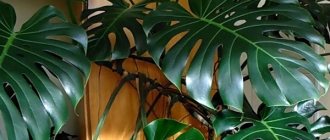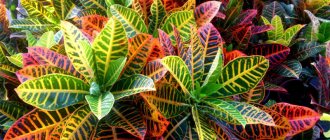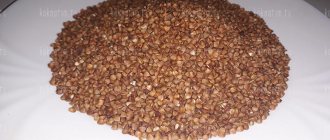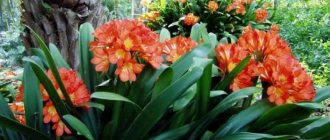Echinocactus is a spherical succulent common in the deserts of Central America. Other the name of this genus is hedgehog cactus, from the Greek word for hedgehog - echinos.
It is bred as a house and garden plant, takes root well in slightly acidic porous soil, but is sensitive to frost and dies from low temperatures.
Types of Echinocacti
There are 6 types, each of which has characteristic differences.
Echinocactus grusonii (Gruzoni)
Endemic to eastern and central Mexico, but rare in the wild and endangered. Habitat: basalt substrate on the slopes of hills, at an altitude of about 1,400 m.
It was first described by the German botanist Heinrich Hildmann, who named the species in honor of his compatriot Hermann Gruson
Outwardly it resembles a large, almost regular ball. After many years it reaches a meter in size. Young specimens differ in appearance from mature ones. Life expectancy is approximately 30 years.
Adults may have up to 35 distinct ribs, although in the initial stages of growth only small projections are noticeable. The sharp, long spines are usually straight or slightly curved and come in shades of yellow and sometimes white.
After reaching approximately 20 years of age, small yellow flowers appear on Gruzoni's crown each summer.
Echinocactus platyacanthus (broad-spined or flat-spined)
Comes from the Chihuahuan Desert. Residents of Mexico prepare traditional sweets from it by boiling the pulp. The plant reaches a height of 2.5 m and a width of 1.5 m. It lives for more than a hundred years. It has a grayish-blue stem with hard spines.
The top is flat and covered with a yellow fibrous texture. There is strong ribbing and large areolas. The flowers bloom at the turn of the spring and summer seasons and bear small, hairy fruits.
Echinocactus parryi (parry)
Oblate-spherical or short cylinder-shaped, morphologically reminiscent of polycephalus. The plant has a grey-green stem 20–30 cm long with distinct ridges. The needles are white or pinkish, arranged in bunches, almost completely covering the plant. Flowering occurs in summer.
Echinocactus horizonthalonius (horizontal)
Natural environment - limestone substrates of the Sonoran and Chihuahuan deserts. The color varies from gray-green to bluish-gray, and the shape is spherical, hemispherical , cylindrical or oblate.
Extends up to 45 cm with a width of 20. Consists of sections that bend slightly around the longitudinal axis, like a screw. Bright pink or purple-red flowers, 7–9 cm in diameter, bloom in June. The buds open in the middle of the day and close at night.
Echinocactus polycephalus (multi-headed)
Homeland - the most arid regions of the American continent - the Mojave Desert and the northern part of Sonora.
It can be solitary, but more often it forms clusters of up to 30 specimens, each up to 0.6 m in height. Frequent, strong spines cover the stem and prevent the buds from fully opening. Flowering period – July. Brown needles turn red from moisture.
The cactus finds it difficult to take root due to its weak roots.
Echinocactus texensis (Texas)
True to its name, it comes from Texas and surrounding areas.
The cactus is hardy: solitary in the early stages of growth, occasionally forming clusters over the years. Shade options range from gray-green to grassy. The plant has many ribs. The aboveground part is hemispherical, with a flat top.
Small but hard spines grow in bunches. As a rule, the Texas subspecies sits deep in the ground, rising above the surface by about 20 cm with a diameter of 30. It blooms easily, takes root well , and is more frost-resistant than other species.
What does Echinocacus look like?
Echinocactus at a young age is similar in shape to a ball, but over time it begins to acquire a barrel-shaped shape - it stretches upward. Over the years of its life, a cactus can grow up to one meter in diameter and, given optimal conditions, does not begin to produce children.
The surface of the cactus is dark green and glossy, there are numerous ribs with firmly held pubescent areoles - at the very top of the plant they form a soft yellow “cap”. This is shown in photographs of Echinocactus. Most often, the spines themselves are colored yellow, and the largest ones can be about five centimeters in length.
Blooming echinocactus is a fairly rare occurrence. And all because for flowering several important conditions must be met. So, the age of the plant must be at least one-fifth of a century, and the diameter of the stem itself must be more than forty centimeters.
Echinocactus flowers measure 5 by 7 centimeters and form a kind of wreath at the top in the form of pubescent tubes.
There is a wide variety of colors when choosing a plant, for example, red echinocactus is quite common. However, the most popular are cacti with light, almost white, spines.
How to care for Echinocactus Gruzoni
This species is also known as Echinocactus Grusona. It adapts to the artificial environment more easily than its fellows, as a result of which it has become the most common representative of the genus among domestic cacti.
There are copies of alternative colors on sale - Gruzoni red or Gruzoni rainbow, but the most common shade remains golden.
Lighting
When placed outdoors, it requires plenty of sun: the plant should be kept open or in partial shade if exposed to bright sun. In the room, the cactus is located at a point with increased access to daylight and direct sunlight.
Tolerates moderate shade. After a long stay in the shade, gradual adaptation is required before fully exposing the plant to the sun. Otherwise there is a risk of severe damage.
Temperature
Can tolerate brief periods of frost, provided the cold is not severe. For the safety of Gruzoni, it is recommended to provide frost protection if the temperature is expected to drop .
Watering
Regular watering is required throughout the summer growth cycle. There should be enough water, but not too much: the soil should be allowed to dry before adding the next portion. Avoid getting moisture on the stem exposed to the sun. This will cause burns and scars , and possibly fungal infection and death. Winter watering is sporadic; most of the time the cactus is kept dry. Stagnation of water around the roots is unacceptable at any time of the year.
The soil
Saturated, porous soil with a small humus content is suitable for Gruzoni. When kept in a pot, if the roots are cramped, replanting is preferable in the spring. To ensure the freshness of the soil, the procedure is carried out annually.
However, a larger vessel is not always necessary. Up to a quarter of the volume is filled with crushed stone and gravel to maintain the required permeability . In summer, fertilizer with a high potassium content is added.
Choosing a pot
The size of the vessel is not too large, otherwise rot will develop in the roots. At the same time, the plant should not be crowded. It is necessary to provide a shallow but sufficient depth to accommodate the drainage layer and soil. The latter should conduct moisture well and not remain damp for a long time. When the pot becomes too small, a replacement is selected not to spare, but according to size, in order to eliminate problems with the roots.
This video explains how to care for echinocactus gruzoni at home.
Planting and transplanting
Replanting after purchase (important aspects):
- the size of the hole is at least twice the volume of the root system;
- distance to nearest neighbors. If the location is chosen in the garden , then the distance should be at least 2.5 times the circumference of the cactus;
- drainage made of quartz sand or crushed stone is laid on top of the ground;
- the soil is pressed down to eliminate potential voids ;
- The first watering should be plentiful.
When Gruzoni is placed in the garden, the owner first allows it to adapt to unfiltered solar radiation. The cactus is exposed daily for at least a week . The duration of sessions starts from 1 hour and gradually increases.
Attention! Only adult representatives of the species are able to tolerate intense radiation and midday heat.
Replanting means stress for the plant and is not done without reason. The reason is depletion of the nutrient medium, as well as excessive growth of roots when they become visible on the surface or in drainage holes.
During the moving process, the adhered substrate is carefully removed. The diameter of the new vessel should be approximately 3 cm larger than the old one.
How to replant a cactus
Take a pot (possibly plastic), with a diameter slightly larger than the size of the plant. Cacti do not like large pots.
Advice
Do not take clay and ceramic pots without glaze! Plants look beautiful in them, but the clay “breathes” after watering, evaporating water. And this cools the roots. Cold and dampness are the most dangerous enemy of any cactus!
Choose a pot after you have removed the plant and looked at the length of the roots from the root collar. Add another 2 cm for drainage and 2 cm for powdering the root collar. This will be the height of the pot.
How to replant? Drainage (expanded clay) is poured onto the bottom, in a layer of 1–1.5 cm, then a layer of mixture so that the roots touch the ground, and then holding the cactus by the lower part (spiky ones can be hung in a ring on three knitting needles, like a cauldron over a fire), Gently sprinkle the mixture in a circle.
Make sure that the roots do not lift up, but lie down freely. After light compaction, sprinkle the root collar with coarse washed sand. Now the plant needs to be watered.
So the plant needs to be replanted into fresh soil annually, before the end of hibernation - in February. And then you will need to look for a larger pot.
Diseases and pests
Gruzoni has good disease resistance. They are usually caused by improper or overly careful care. The main negative factor is moisture saturation - excess will quickly cause rotting.
Shchitovka
Infestation by scale insects is indicated by the appearance of brown spots of foreign material. Such scales are easy to pick up and separate from the stem , which confirms the presence of a pest. The solution to the problem is to treat the surface of the cactus with cotton wool soaked in alcohol. Another method for more serious cases is insecticide treatment.
Cactus mite
A small arthropod almost invisible to the naked eye. A sign of infection is the formation of a brown rash on the cactus. For control, special means are used to kill ticks - acaricides. To prevent relapse, a second one is done a week after the first treatment.
Chervetsy
Noticing a white coating between the sections and on the areoles, the owner of the cactus begins to prepare to counteract the scale insects. Signs appear at a later stage of the infestation as the pests first settle in the root area. An earlier symptom will be causeless darkening of the stem.
Getting rid of insects is relatively easy. The plaque is washed off in the shower, and then the plant is sprayed with a mixture of soap suds and a little alcohol. The procedure must be carried out daily for a week or more. You can use vinegar instead of alcohol.
Attention! Suspicion of scale insects, like other pests, is a reason for immediate quarantine to avoid migration to other plants.
Wintering
Gruzoni is in a state of deep rest from December to February, when vital processes slow down significantly.
The plant overwinters at temperatures not lower than 10 °C. The cooler it is, the less water the cactus needs. At the same time, it tolerates room heat well. Then the need for moisture increases, but it is significantly lower compared to the summer period.
It is important to choose a well-lit place for the wintering Gruzoni and regularly check it for the presence of parasites. Warm, dry air near the battery creates an environment attractive to pests .
Cool wintering is recommended for mature plant specimens, as this increases the likelihood of flowers appearing.
Typical gardener mistakes and reactions to them
Echinocactus Gruzoni is undemanding in care. Nevertheless, he does not remain indifferent to the gardener’s mistakes, reacting to them by deteriorating his appearance. To return a plant to its former decorative appearance, you need to learn to understand what exactly it is not happy with.
Table: how the echinocactus Gruzoni reacts to the grower’s mistakes
| What does the plant look like? | What is the reason? |
| Vague beige-brown spots on the stem. | Low temperature content. |
| Light green or yellowish spots on the stem. | Nutrient deficiency. |
| Rust, copper or reddish spots on the stem. | The plant is standing in a cold draft or has suffered from a sudden change in lighting. |
| Black spots and mold on the base of the trunk. | Too much watering. Rot develops even faster if the room is cool. |
| The plant turns from a ball into a “cucumber”, the spines become thinner and longer, and break easily. | Lack of light. |
| The spines become thinner and deformed, and growth almost stops. | Lack of fertilizers. Other possible reasons are watering with cold water, frequently moving the pot from place to place, skipping a dormant period, replanting without urgent need. |
| The plant bursts. | Unsuitable for cacti, too nutritious soil. Excess nitrogen or natural organic matter in the soil makes the situation worse. |
| The stem dries out, wrinkles, and hardens. | Too little watering. Especially in the summer, in the heat, when the room is too hot. |
Rusty spots on the stem appear due to the unfortunate location of the Echinocactus Gruzoni
Experienced cactus growers do not recommend placing these plants next to Saintpaulias (violets), believing that their pollen has a negative effect on their pets. There is no scientific data on this matter, but some prefer to play it safe, believing that it won’t get worse in any case.
Blooming Gruzoni
The appearance of flowers occurs at the turn of the spring-summer seasons in representatives of the species older than 20 years. judged by the diameter: once a given age is reached, the width of the stem is usually greater than or equal to 40 cm. Even if the size and age meet the criteria, flowers may not appear if the cactus has not received enough sun.
Important! If all conditions are met, small tubular crowns bloom at the top of the stem, bordering it. The petals are narrow and elongated, dark yellow.
Botanical portrait
In indoor conditions, the Gruzoni echinocactus (Echinocactus grusonii) grows no more than 40 cm in diameter. It rarely branches, except as a result of damage to the stem. Children formed on the plant most likely indicate some kind of dysfunctional process with it. It is advisable to use them for rooting, so as not to completely lose the flower.
The stem is bright green, consists of 30-40 ribs, densely covered with strong yellow spines, although there are alba forms with white needles. Each areola usually contains 1-4 central needles and up to 10 radial needles directed in all directions. The top of the ball seems to be dotted with yellow fluffs - this impression is created due to the formation of young areolas.
Flowering in indoor cultivation rarely occurs, only at a much mature age. The flowers are small, short-tubular, arranged in a ring around the crown of the ball, the petals are narrow, light yellow.
On sale there are forms of Echinocactus Gruzoni E. grusonii f. alba and E. grusonii f. curvispinus.
Reproduction
Each year, mature specimens produce a sufficient number of fruits. As the flower dies, the seed pods are collected for propagation.
Seeds
The bolls are easily separated from the surrounding fibers. One side of the container is cut with a knife and the contents are removed with the same tool. Small red-brown seeds are placed in water overnight . The tray in which the ripening will take place is filled with a mixture of peat and vermiculite in a ratio of 6:4 and the same amount of coarse sand.
Seeds with water are drawn into a large syringe and distributed evenly over the tray. There is an opinion that it is useful to keep the seeds in the refrigerator for a year before planting .
The tray is placed in light sun and covered with glass. The substrate is kept moist until germination - 2-6 weeks. Young shoots look like miniature red spheres. Next, the glass is gradually removed.
When small cacti begin to produce needles, the gardener uses tweezers to transfer them into five-centimeter vessels filled with the same mixture as the tray. Here the plants spend 1–2 years and are then transferred to 10 cm wide pots.
This video shows one of the methods of propagating Echinocactus gruzoni by seeds.
Children
Under normal conditions, Gruzoni does not produce branches, so vegetative propagation is impossible. The appearance of lateral shoots is evidence of damage to the stem as a result of mechanical stress or disease. The result is stunting of growth and sometimes death of the cactus.
Noticing the appearance of side shoots, the cactus grower pays special attention to them in order to have time to cut them off if the main stem dies . Having successfully planted the shoot, the owner receives a new plant.
Echinocactus Gruzoni is well suited for interior decoration and adding color to the room. The regular spherical shape and bright golden color combine to create a positive visual impact. Taking into account how easy it is to care for at home, it becomes clear that the plant is very popular among lovers of indoor floriculture .
Appearance and features
Growing exotic plants, in particular various types of cacti, is a hobby for many people.
The genus echinocactus (from the Greek “echinus” - sea urchin) includes 6 spherical cacti, each of which actually looks somewhat like a curled up urchin. These include:
- flat-spined;
- Parry;
- Texan;
- polycephalus;
- horizontal;
- Gruzoni.
As it grows, the “hedgehog” tends to stretch upward somewhat, so the second unofficial name of the plant is “golden barrel”. Under favorable conditions, the plant does not bush and appears as free-standing “barrels”; sometimes you can find a whole family of such “barrels” stuck together.
The species "Gruzon" was named after the German engineer and inventor Hermann August Gruson, who was passionately interested in plants and amassed a significant collection of cacti. This species has a rounded ribbed shape and many sharp spines, some of which are straight and some are curved.
Unlike the size of its counterparts growing in the natural environment, even with proper care of echinocactus at home, its size usually does not exceed the diameter of a watermelon.











